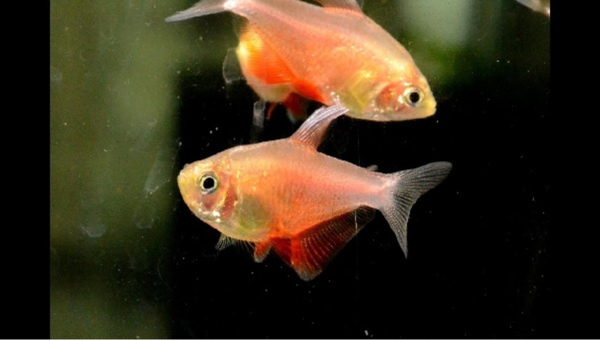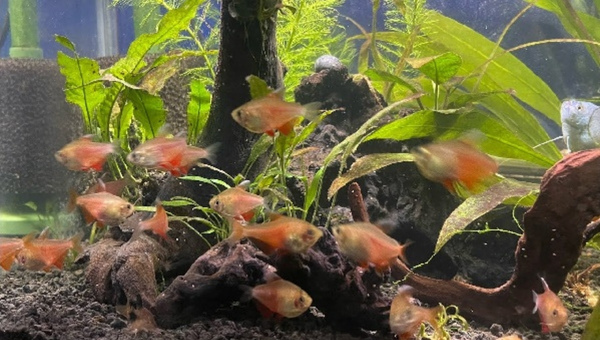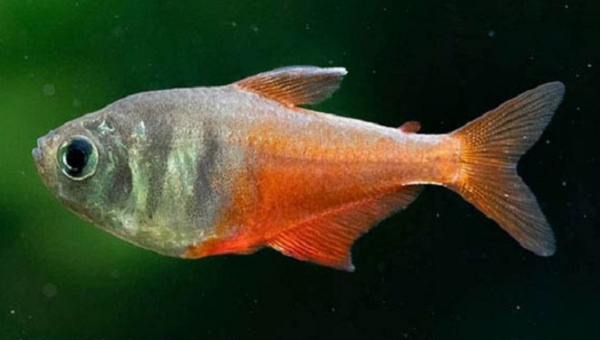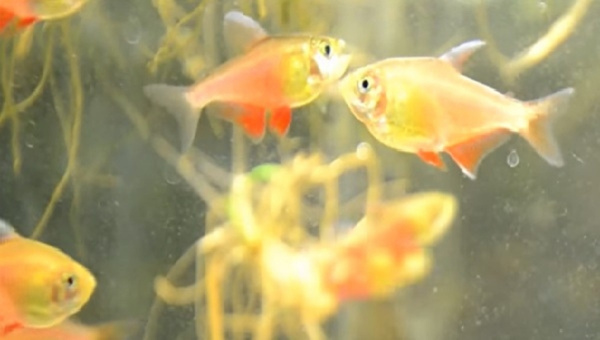Here, we will share the complete guide to Flame Tetra care. Flame Tetras are peaceful and beautiful freshwater fish that make a great addition to any aquarium. They are easy to care for and are compatible with most other fish species.
These fishes are suitable for beginners and make an excellent choice for a community aquarium. If you spy one at the pet store lacking the vibrant coloring you’ve seen in pictures, you can chalk it up to stress.
Once you get them home, provide them with optimal conditions, and lower their stress levels, you should notice an uptick in hue.
It’s an essential lesson about the adverse effects of stress on your aquarium fish and a reminder about how important it is to curate a tank experience that reduces stress as much as possible.
They are found in slow-moving rivers and streams in Rio de Janeiro, Guandu River basins, and São Paulo (upper Tietê River basin).
They are accustomed to coastal waters that are shallow and slow-moving. Because of this, they are not well-suited to life in a fast-moving river or stream. They are primarily found in rivers, streams, and tributaries; they like sandy substrates with underwater plants and do well in either clear or brown water.
These attributes are easily achievable in a home aquarium, which is one of the reasons these fish are appropriate for beginners.
Their scientific name is Hyphessobrycon flammeus. They are part of the Characid family, which contains over 1,700 freshwater fish species. They are also known by some other common names, which are:
- Fire Tetra
- Green Fire Tetra
- Rio Tetra
- Von Rio Tetra
This guide will teach you everything you need to know about Flame Tetra care to keep them in your aquarium successfully.
Table of Contents
- Species Summary
- Flame Tetra Care Guide
- Flame Tetra Food and Diet
- Flame Tetra Tank Size
- Flame Tetra Water Parameters
- Flame Tetra Filtration
- Flame Tetra Heating
- Flame Tetra Lighting
- Flame Tetra Substrate
- Flame Tetra Plants
- Flame Tetra Decoration
- Cleaning the tank
- Cleaning The Filter
- Flame Tetra Common Possible Diseases
- Flame Tetra Treatment and Medications for Diseases
- Flame Tetra Tank Mates
- Advantages Of Having Flame Tetra In Your Tank
- Disadvantages Of Having Flame Tetra In Your Tank
- Summary
Species Summary
| Scientific name | Hyphessobrycon flammeus |
| Family | Characidae |
| Origin: | Southeast Brazil |
| Other Name: | Red tetra or Rio tetra |
| Care Level | Easy |
| Temperament | Peaceful |
| pH Level: | 5.5-7.5 |
| Water Temperature: | 72°-82°F |
| Water hardness: | 3-15 dGH |
| Color Form | Silver and Red |
| Lifespan | 3-5 years |
| Size | 0.8-1 inch |
| Diet | Omnivore |
| Minimum Tank Size | 15 gallons |
| Compatibility | Peaceful |
Flame Tetra Appearance
Flame Tetras are small, slender fish with long fins. The body is silver with a red or orange stripe running along the length of the fish. The fins are also red or orange.

Stress and environment affect the intensity of the Flame Tetra’s coloring, so a fish kept in less-than-ideal conditions may appear pale and lackluster. The sexually mature Flame Tetras have a more intense color than the juvenile Flame Tetras.
Also, check Neon Tetra Care Guide: Appearance, Breeding & All
Flame Tetra Size and Growth Rate
Flame Tetras reach a maximum size of about 1 inch. They grow relatively slowly and usually only grow to their full size after almost 2 years. It is on the smaller side, a consideration when choosing tank mates.
If you wait to pair them with larger fish, provide plenty of hiding places so the little ones can escape when needed. If you pair them with other tetras, they may harass the smaller ones, so it’s important to pair them with the same size or keep an eye on interactions and separate them if necessary.
Check Black Neon Tetra 101: Best Care Guide, Species Summary & All
Flame Tetra Lifespan
The average lifespan of a Flame Tetra is 3-5 years. However, they can live up to 10 years or more with proper care and tank conditions.
Flame Tetra Behavior and Temperament
Flame Tetras are peaceful fish and can be kept with various other fish. The only fish that they should not be kept with are aggressive.

Flame Tetras are schooling fish and should be kept in groups of six or more.
Flame Tetras are not aggressive, and they will not bother other fish.
Difference Between Male and Female Flame Tetra
Males and females are very similar in appearance, but there are a few ways to tell them apart. One way is to look at the fins. The fins of males are usually longer and more pointed than the fins of females. Another way to tell them apart is by looking at their bellies. The belly of a female is usually rounder than the belly of a male.
Males are more brightly colored than females and also have black stripes on their anal fins and a bony hook on their anal and abdominal fins that they use for mating.
The females don’t have a hook, but their anal fin curves. Females also have different silver-yellow coloring on the abdomen that the males do not have.
Check Emperor Tetra 101: Care, Breeding, Lifespan, Diet
Flame Tetra Breeding
Breeding Flame Tetras is not tricky, but it does require a bit of preparation. To breed Flame Tetras, you must set up a breeding tank. The breeding tank should be at least 20 gallons, and it should have a sponge filter. The water in the breeding tank should be soft and acidic.
To trigger spawning, you must provide the fish with live foods, such as bloodworms and brine shrimp. You will also need to lower the water level in the tank so that it is about half full.

When the fish are ready to spawn, they will lay their eggs on the plants in the tank. The eggs will hatch in about 24 hours.
After the eggs have hatched, remove the fry from the breeding tank. The fry can be kept in a separate tank or the main tank.
The fry should be fed small amounts of food several times a day. A good diet for fry includes:
- Infusoria
- Daphnia
- Brine shrimp
After about two weeks, the fry will be large enough to eat Tetra Min Tropical Flakes.
You may also check Cardinal Tetra 101: Species Summary & Ultimate Care Guide
Flame Tetra Care Guide
Flame Tetras are peaceful fish that do well in community tanks. They are not aggressive and get along with other fish of the same size or larger. They should not be kept with larger, more aggressive fish that may bully them.
The ideal tank size for Flame Tetras is 15 gallons or more. They should have plenty of hiding places and some plants to help them feel comfortable. The tank should have a tight-fitting lid as these fish are known to jump out of tanks that are not well-covered.

The water temperature for Flame Tetras should be between 72° to 82°Fahrenheit. The pH should be between 5.5 to 7.5, and the water should be soft to medium hard.
Although your Flame Tetras are adaptable to various water conditions, they will suffer if their water is unclean or moves too fast for their liking. Their hue can also suffer if they are put in a tank without other Flame Tetras or if they are paired with fish that are much larger and more aggressive than they are.
You would be better off remedying the causes of stress that are making your fish lose their color in the first place. Perform regular water changes, test the water conditions, and ensure their habitat and environment are suitable.
Flame Tetras are omnivores and will eat a variety of foods. They should be given a diet that includes both plant and animal matter. Good quality flake or pellet food can be used as the base of their diet.
They should also be given live, frozen, or freeze-dried foods as a treat. Brine shrimp, bloodworms, and daphnia are all good choices.
Vegetables such as lettuce, spinach, and zucchini can also be given to them. These vegetables should be blanched or steamed before being added to the tank, making them more accessible for the fish to digest.
Flame Tetras should be fed 2-3 times a day in small amounts that they can eat in 1-2 minutes. Providing them with smaller meals more often than one large meal is better.
You may also check Green Neon Tetra 101: Fun Facts, Breeding, Care Guide & All
Flame Tetra Food and Diet
Flame Tetras are omnivores; their diet should consist of meat and plants.
A good diet for Flame Tetras includes:
- Tetra Min Tropical Flakes
- Algae
- Bloodworms
- Brine Shrimp
- Krill
- Cucumbers
- Zucchini
- Daphnia
- Detritus
- Flakes
- Spinach
- Granules
- Mosquito larvae
- Tablets
- Tubifex
Flame Tetras should be fed two to three times a day. The amount of food that they eat should be based on their size. A good rule of thumb is to feed them enough food so that they can eat it all in two minutes.
Check Rummy Nose Tetra 101: All You Need To Know
Flame Tetra Tank Size
The ideal tank size for Flame Tetras is 15 gallons or more. They should have plenty of hiding places and some plants to help them feel comfortable. You’ll need about 2 gallons for each fish; if you have a community tank with other species, you’ll need more room.
The tank should have a tight-fitting lid as these fish are known to jump out of tanks that are not well-covered. Ensure you leave them enough space to swim around in their schools. They like to swim through the plants, but if the tank is over-decorated, they won’t be able to swim freely and may become stressed.
They have brownish water in the wild, so don’t be surprised if your water turns a little bit yellow after you add them to the tank. This is normal and not harmful to the fish.
Flame Tetra Water Parameters
The water temperature for Flame Tetras should be between 72° to 82°Fahrenheit. The pH should be between 5.5 to 7.5, and the water should be soft to medium hard.
You should check conditions regularly; while Flame Tetras have a wide range of acceptable parameters, they don’t do well with abrupt changes.
Flame Tetras are schooling fish, so you’ll need at least 6 of them to feel comfortable in their new home. Use should always use a sound filtration system, and we recommend a power filter. Changing 10-20% of the water daily is essential to keep the tank clean and the fish healthy.
Also, check Best Ruby Tetra Guide
The optimal parameters for Flame Tetras are:
- pH levels: 5.5 to 7.5
- Water hardness: 3 to 15 dGH
- Water temperature: 72°F to 82°F (22.3-27.8°C)
Flame Tetra Filtration
The filtration system is essential for the health of your Flame Tetras. We recommend a power filter, and you should change 10-20% of the water each week to keep the tank clean and the fish healthy. The filter should be able to circulate the entire volume of water in the tank at least 3 times per hour.
The AquaClear Power Filter and Fluval External Canister Filter are commonly recommended filters. Some other filters are also suitable, but make sure you choose one that is appropriate for the size of your tank.
Names of good filters are:
- AquaClear Power Filter
- Fluval External Canister Filter
- API Filstar XP Canister Filter
- Eheim Classic Canister Filter
- Hydor Professional External Canister Filter
- Marineland Magniflex Glass Canister Filter
- Penn Plax CascadeCanister Aquarium Filter System
- Red Sea Reefer Deluxe 350 White Aquarium
Flame Tetra Heating
The water temperature for Flame Tetras should be between 72° to 82°Fahrenheit, so you may need to use a heater to maintain the correct temperature. We recommend the Fluval E Series Heater. This good quality heater is easy to use and will help you keep your tetras healthy.
Also, check Silver Tip Tetra Guide
Some good quality heaters are:
- Fluval E Series Heater
- Aqueon Submersible Aquarium Heater
- Hydor Theo 50Watt Aquarium Heater
- Tetra submersible aquarium heater
- Zoo Med Nano 10 Gallon Glass Aquarium Kit with LED Lighting and Power Filter
Flame Tetra Lighting
Flame Tetras do best in a dimly lit tank. They are shy fish, and too much light makes them uncomfortable. You can use a fluorescent tube or an LED light for their tank. We recommend a white or blue light to show off their colors best.
The lighting should be on for 10-12 hours a day. You can use a timer to turn the light on and off, so it’s consistent.
Some good lighting choices are:
- Fluval AquaSky LED Light
- Current USA Satellite Freshwater LED Plus Light
- Beamswork EA Timer FWE LED Aquarium Light
- Aqueon Modular LED Aquarium Lighting System
- Finnex Planted+ 24/7 Fully Automated Aquarium Led
- Orphek Atlantik V2 Full Spectrum LEDs
- Kessil A360WE Tuna Blue LED Aquarium Light
- Nicrew Classic LED Aquarium Light
Flame Tetra Substrate
The substrate is not as crucial for Flame Tetras as for other fish. They don’t need a particular type of substrate, and any gravel or sand will do. If you want to grow plants in the tank, we recommend using a soil-based substrate like Aqua Soil.
Check Otocinclus Catfish Care Guide: Appearance, Lifespan, Food & Diet, Breeding & All
Some good substrate choices are:
- Aqua Soil
- Seachem Fluorite Black Sand
- CaribSea Eco-Complete African Cichlid Zack man’s Blend
- Fluval Plant and Shrimp Stratum
- Estes’ Gulf Coast White Sand
- Hikari Cichlid Golds Premium Aquarium Sand
Flame Tetra Plants
Flame Tetras are peaceful fish, so that you can keep live plants in their tank. They will swim through the plants and hide in them when they feel scared or threatened. Some good plant choices for their tank are Java Fern, Hornwort, and Anacharis.
Also, check Otocinclus Catfish Care Guide: Appearance, Lifespan, Food & Diet, Breeding & All
Some good plant choices are:
- Java Fern
- Hornwort
- Anacharis
- Water Sprite
- Duckweed
- Frogbit
- Cryptocoryne wendtii
- Nymphaea Lotus Zenkeri
- Bacopa Carolinians
- Hygrophila pinnatifida
Flame Tetra Decoration
You can decorate the tank with rocks, driftwood, and other aquarium-safe decorations. Be sure to avoid anything that could have sharp edges or that might fall and break the glass. The decorations will give the fish places to hide and make them feel more comfortable in their environment.
Some good decoration choices are:
- Zoo Med Aquatic Eco Earth
- Penn Plax Stone Replica Aquarium Decorations
- GloFish Aquarium Kit with Blue LED Light Plus Fish Food and Water Conditioner
- API Reef Master Test Kit
- Aqueon QuietFlow LED PRO Aquarium Power Filters
- Tetra AquaSafe Plus Water Conditioner
- Seachem Prime Fresh and Saltwater Conditioner
- Nutrafin Max Fish Food Flakes
Cleaning the tank
You should perform a partial water change of 15% every other week. You will also need to vacuum the gravel and clean the filter media. Rinse the filter media in old tank water to prevent disrupting the beneficial bacteria colony.
Check Butterfly Betta Care Guide: Appearance, food & Diet, Breeding & All
To clean the tank, you will need the following:
- A sponge: A sponge can be used to wipe down the inside of the tank.
- A toothbrush: A toothbrush can be used to clean the filter.
- Freshwater: You will need fresh water to rinse off the sponge and toothbrush.
The steps for cleaning the tank are as follows:
- Remove the fish from the tank and put them in a temporary home.
- Remove all of the decorations from the tank.
- Use the sponge to wipe down the inside of the tank.
- Rinse the sponge and toothbrush with fresh water.
- Use the toothbrush to clean the filter.
- Rinse the sponge and toothbrush with fresh water.
- Add the decorations back to the tank.
- Add the fish back to the tank.
It is essential to clean the tank regularly to prevent the build-up of algae and bacteria. Algae and bacteria can be harmful to fish, and they can also cause the water to become cloudy.
Cleaning The Filter
It is essential to clean your filter regularly. A dirty filter can cause problems for your fish.
To clean your filter, you will need the following:
- A clean bucket: We will use it to hold the old water.
- A garden hose: It is used to rinse the filter media.
- Filter media: This is used to replace the old media.
To start, you will need to remove the filter from your tank. Then, use the clean bucket to hold the old water. Next, use the garden hose to rinse the filter media. Finally, replace the old media with new media.
Check Panther Grouper Care Guide: Appearance, Lifespan & Coloration & Breeding
Flame Tetra Common Possible Diseases
Flame Tetras are prone to a few common diseases.
The most common diseases are:
- Ich: Ich is a parasitic infection that causes white spots on the fish. Ick can be treated with several medications, including Copper safe and Praziquantel.
- Finrot: Finrot is a bacterial infection that causes the fins to rot. Finrot can be treated with several different medications, including Maracyn and Kanaplex.
- Dropsy: Dropsy is a disease that causes the fish to swell up. Dropsy can be treated with several different medications, including Levamisole and Metronidazole.
Also, check Ultimate Dragon Goby 101: Care, Appearance, Food, Habitat & All
Flame Tetra Treatment and Medications for Diseases
Several different medications can be used to treat diseases in fish.
The most common medications are:
- Copper safe: Copper safe is a medication used to treat ich.
- Praziquantel: Praziquantel is also used to treat ich.
- Maracyn: Maracyn is used to treat fin rot.
- Kanaplex: Kanaplex is a medication that is used to treat fin rot.
- Levamisole: To treat dropsy, Levamisole is the best medication.
- Metronidazole: Metronidazole medication is best to treat dropsy.
If you think your fish is sick, you must take them to a vet for a diagnosis. A vet will be able to prescribe the proper medication for your fish.
Check the 12 Most Popular Types Of Danios: Appearance, Care, LIfespan & Al
Flame Tetra Tank Mates
Flame Tetras can be kept with a wide variety of fish. Some good tank mates for Flame Tetras include:
- Guppies
- Mollies
- Platies
- Swordtails
- Danios
- Tetras
- Barbs
- Rainbowfish
- Corydoras catfish
- Kuhli loaches
- Snails
- Shrimps
Advantages Of Having Flame Tetra In Your Tank
Flame Tetras are very colorful fish and add a lot of beauty to a tank. They are also very peaceful and get along well with other fish. The other advantages are that they are easy to care for and they are not expensive.
Check Bellus Angelfish Care: Appearance, Size, Lifespan, Diet & All
Disadvantages Of Having Flame Tetra In Your Tank
The only disadvantage of having Flame Tetras is that they are susceptible to changes in water conditions. If the water in their tank is not kept clean, they can get sick and die.
Other Disadvantages are that they are not very resistant to disease and are not very tolerant of changes in water conditions.
Summary
Flame Tetras are good fish for both beginners and experienced aquarium keepers. They are easy to care for, and they are lovely. However, they are susceptible to changes in water conditions, so keeping the water in their tank clean is essential.
They are also easy to breed, so Flame Tetras are an excellent choice if you want to explore this aspect of fishkeeping.
Thank you for reading my guide on Flame Tetra care. I hope that you have found it helpful and that you will be able to provide your fish with the best possible care.



